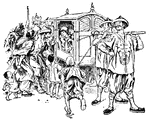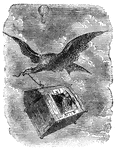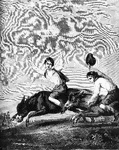!["Assault of the Second Louisiana [African American] Regiment on the Confederate works at Fort Hudson, May 27th, 1863. The Battle of Fort Hudson was a severe and well-fought action. The Federal troops displayed their usual bravery, and were well handled by General Banks, driving the enemy to his second line of works. Of the [African American] regiments General Banks, in his official report, says: 'They answered every expectation. Their conduct was heroic. No troops could be more determined or more daring. They made during the day three charges upon the batteries of the enemy, suffering very heavy losses, and holding their position at nightfall with the other troops on the right of our line. The highest commendation is bestowed upon them by all officers in command on the right. Whatever doubt may have existed heretofore as to the efficiency of organizations of this character, the history of this day proves conclusively to those who were in a condition to observe the conduct of these regiments that the Government will find in this class of troops effective supporters and defenders. The severe test to which they were subjected, and the determined manner with which they encountered the enemy leave upon my mind no doubt of their ultimate success. They require only good officers, commands of limited numbers, and careful discipline to make them excellent soldiers.'"— Frank Leslie, 1896](https://etc.usf.edu/clipart/11800/11805/ft-hudson_11805_mth.gif)
Fort Hudson
"Assault of the Second Louisiana [African American] Regiment on the Confederate works at Fort Hudson,…
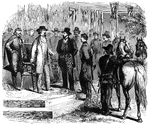
Siege of Vicksburg
"The siege of Vicksburg. General Grant meeting the Confederate General Pemberton at the Stone House,…
!["Siege of Petersburg- the Ninth Corps charging on the enemy's works after the explosion of the mine, July 30th, 1864. Immediately after the explosion of the mine a hundred cannons opened along the Federal front, and at half-past five the Ninth Corps charged, carrying the fort with a part of the line on each side. The Second Division, which was in the centre, advanced and carried the second line a short distance beyond the fort, and rested, holding ground with the utmost determination. It was at the time the [African American] Division, under General White, was pushed forward and ordered to charge and carry the crest of the hill, which would have decided the contest. The troops advanced in good order as far as the first line, where they received a galling fire, which checked them, and although quite a number kept on advancing, the greater number seemed to become utterly demoralized, part taking refuge in the fort, and the remainder running to the rear as fast as possible. They were rallied and again pushed forward, but without success, the greater part of the officers being killed or wounded."— Frank Leslie, 1896](https://etc.usf.edu/clipart/11800/11856/petersburg_11856_mth.gif)
Siege of Petersburg
"Siege of Petersburg- the Ninth Corps charging on the enemy's works after the explosion of the mine,…

Stage
Inhabitants gathered on an erected stage to give the Author a speech. Speaking in a threatening manner,…
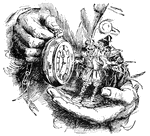
Pocketwatch
Gulliver shows the Lilliputians his gold pocketwatch. Never seeing anything like it before they believed…

Giant Sitting on Wall
Gulliver sitting on a building in Lilliput with all the Lilliputians gathered around him.
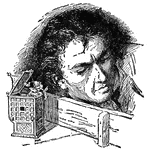
Whispering in Giant's Ear
Gulliver helping the lilliputians in thier war against the people of Blefuscu.
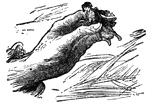
Giant hand holding Gulliver
One of the giants in Brobdingnag picks Gulliver up to get a closer look.

Queen looking in a mirror
The Queen of brobdignag quickly becomes fond of Gulliver. She holds him in her hand showing him around…
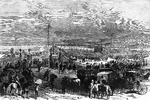
Antietam National Cemetary
"The dedication of the Antietam National Cemetary, at Sharpsburg, Md., on Tuesday, September 17th, 1867.…

Batara
Taking its name from the Azara people of South America, the batara is the largest of the shrikes.

Battle of the Wilderness
"The battle of the Wilderness, between General Grant and General Lee, May 5th and 6th, 1864. Our sketch…

Battle of Carrick's Ford
"Battle of Carrick's Ford, between the troops of General McClellan's command, under General Morris,…

Battle of Williamsburg
"Battle of Williamsburg, Va., on the peninsula between York and James Rivers, May 6th, 1862. General…

Shay's Rebellion
"A scene at Springfield, during Shay's Rebellion, when the mob attempted to prevent the holding of the…
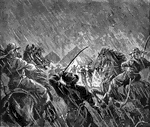
Stuart's Raid
"General J. E. B. Stuart's raid upon Pope's headquarters, August 22, 1862, when Pope's despatch book…
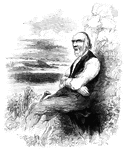
Isaac Rice
Isaac Rice was the name of our octegenarian guide. Like scores of those who fought our battles for freedom,…

Caldwell's Monument
Caldwell's monument. The following are the inscriptions upon the Caldwell monument: East Side: "This…
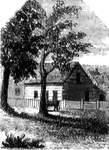
Red House
The Red House. The "Red House" is situated upon the street in Wilkesbarre next the river, and about…

Savin's Rock
Savin's Rock. This is a view of the spot where Farth landed, in Orange, formerly West Haven. It is between…
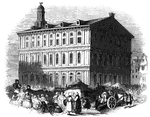
Faneuil Hall
"Faneuil Hall has been denominated 'the cradle of American liberty,' having been the popular gathering-place…
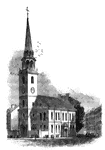
Old South
"The Old South. This venerable and venerated edifice, that stood through all the storms of the Revolution,…
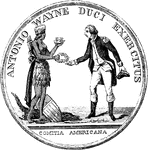
Wayne Medal Front
"Gold medal awarded by Congress to General Wayne. This is a representation of the medal, the size of…
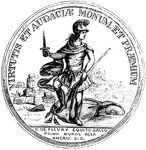
De Fleury Medal Front
"Medal awarded to Lieutenant-colonel De Fleury. This is a representation of the medal, the size of the…
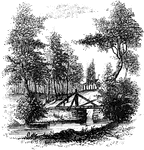
Sleepy Hollow
"Bridge over Sleepy Hollow Creek. Ichabod, according to Irving, in the Legend, returning from…
!["Siege of Petersburg- the Ninth Corps charging on the enemy's works after the explosion of the mine, July 30th, 1864. Immediately after the explosion of the mine a hundred cannons opened along the Federal front, and at half-past five the Ninth Corps charged, carrying the fort with a part of the line on each side. The Second Division, which was in the centre, advanced and carried the second line a short distance beyond the fort, and rested, holding ground with the utmost determination. It was at the time the [African American] Division, under General White, was pushed forward and ordered to charge and carry the crest of the hill, which would have decided the contest. The troops advanced in good order as far as the first line, where they received a galling fire, which checked them, and although quite a number kept on advancing, the greater number seemed to become utterly demoralized, part taking refuge in the fort, and the remainder running to the rear as fast as possible. They were rallied and again pushed forward, but without success, the greater part of the officers being killed or wounded."— Frank Leslie, 1896](https://etc.usf.edu/clipart/13900/13915/petersburg_1_13915_mth.gif)
Siege of Petersburg
"Siege of Petersburg- the Ninth Corps charging on the enemy's works after the explosion of the mine,…
!["Siege of Petersburg- the Ninth Corps charging on the enemy's works after the explosion of the mine, July 30th, 1864. Immediately after the explosion of the mine a hundred cannons opened along the Federal front, and at half-past five the Ninth Corps charged, carrying the fort with a part of the line on each side. The Second Division, which was in the centre, advanced and carried the second line a short distance beyond the fort, and rested, holding ground with the utmost determination. It was at the time the [African American] Division, under General White, was pushed forward and ordered to charge and carry the crest of the hill, which would have decided the contest. The troops advanced in good order as far as the first line, where they received a galling fire, which checked them, and although quite a number kept on advancing, the greater number seemed to become utterly demoralized, part taking refuge in the fort, and the remainder running to the rear as fast as possible. They were rallied and again pushed forward, but without success, the greater part of the officers being killed or wounded."— Frank Leslie, 1896](https://etc.usf.edu/clipart/13900/13917/petersburg_2_13917_mth.gif)
Siege of Petersburg
"Siege of Petersburg- the Ninth Corps charging on the enemy's works after the explosion of the mine,…
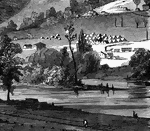
Grafton Occupied by Federal Troops
"View of Grafton, West Virginia, occupied by the Federal Troops, under the command of General McClellan,…
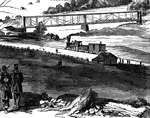
Railroad at Grafton
"View of Grafton, West Virginia, occupied by the Federal Troops, under the command of General McClellan,…
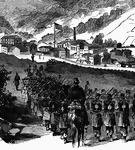
Federal Troops at Grafton, West Virginia
"View of Grafton, West Virginia, occupied by the Federal Troops, under the command of General McClellan,…
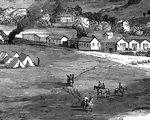
Village of Clarksburg
"Village of Clarksburg, Western Virginia, headquarters of General Rosecrans. Clarksburg, a post village,…
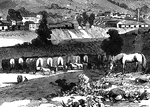
Village of Clarksburg
"Village of Clarksburg, Western Virginia, headquarters of General Rosecrans. Clarksburg, a post village,…

Bastile Key
"Key of the Bastile. This key of the old Paris prison known as the Bastile, was sent by La Fayette to…
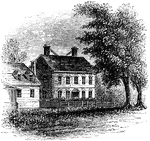
Nelson Mansion
"The Nelson Mansion. This view is from the street looking northwest. A long wooden building, with steep…
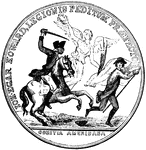
Howard Medal Front
"Silver medal awarded to Colonel Howard. The following are the device and inscriptions upon the front:…
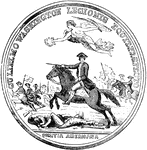
Washington Medal Front
"Silver medal awarded to Washington. The following are the device and inscriptions on the front: An…
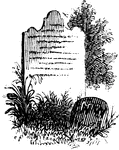
Woodhull's Grave
"Woodhull's Grave. Nathaniel Woodhull was born at Mastic, Long Island, December 30, 1722. Agriculture…
Sowing
"Egyptian Sowing. The people were mainly agricultural, but employed rude methods of cultivation. In…

Miltiades
"The chief credit of the battle of Marathon belongs to Miltiades. But for his courage, the Athenians…

Caesar's Death
"The Death of Caesar. Naturaly such extraordinary success made him enemies, and though the city seemed…
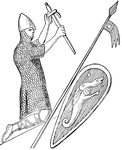
William the Conqueror
"William the Conqueror (1066-1087), as represented on his seal. Although William really ruled 'as king…

Gustavus Adolphus
"Gustavus Adolphus entered Germany at the head of 16,000 men. Among some of the Protestants there was…
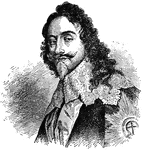
Charles I
"Charles I (1625-1649) was a far abler ruler than his father. He was a man of greater courage and more…
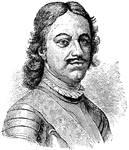
Peter the Great
"Peter the Great. This prince is one of the most extraordinary figures in history. As a boy he showed…
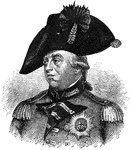
George III, King of England
"George III (1760-1815). The first two Hanoverian kings were ignorant of English politics and obliged…
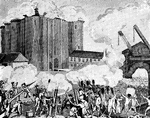
Bastile
"The taking of the Bastile, July 14, 1789. The Parisian mob, not satisfied with the formation of the…

Napoleon
"France under Napoleon. The consulate was the form of government established after the overthrow of…

Garibaldi
"Garibaldi was a patriot who started up a revolt in Sicily and took possession of the island, then passed…

Dutch West India Flag
"Flag of the Dutch West India Company. When the rights of the company ceased, a new and more powerful…
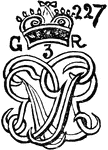
Stamp Act
"Stamp from the Stamp Act. The first direct issue of importance between the colonies and England came…
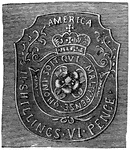
Stamp Act
"Stamp from the Stamp Act. The first direct issue of importance between the colonies and England came…


